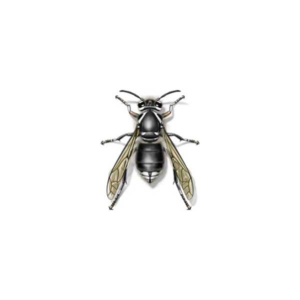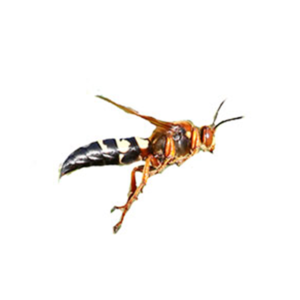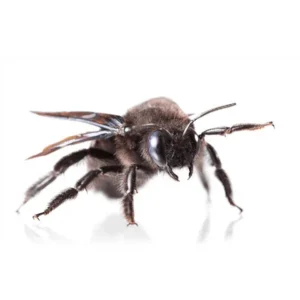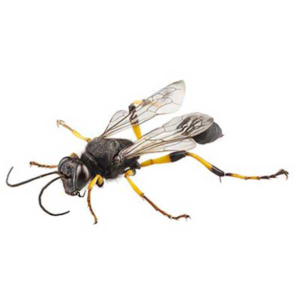Velvet Ant Wasp Identification
What Do Velvet Ant Wasps Look Like?
Velvet ants, despite their name, are a type of wingless wasp. They have a distinct appearance with dense, velvety hair covering their bodies, usually brightly colored red, orange, or yellow with black markings. They resemble large hairy ants, and the larger females are equipped with a powerful sting.
Unsure? We can help you to identify common bee, wasp & hornet species.
Signs of a Velvet Ant Wasp Infestation
The velvet ant wasp is typically seen running around open areas, sometimes erratically, in late summer. They may be seen in lawns or pastures or wandering into buildings. Velvet ants are external parasites of bees and wasps, taking over their nests in the ground. A few species of velvet ants paralyze flies and beetles. Consequently, there are no identifiable nests to treat. Females usually search for host nests on the ground, especially on bare, sandy soil. Male velvet ants are often found on flowers. Adult velvet ant wasps feed on nectar and water. Although uncommon, velvet ant wasps occasionally enter structures in search of prey.
Habitat, Diet, Life Cycle & Stings
Where Do Velvet Ant Wasps Live?
Velvet ants are found in various habitats, including grasslands, forests, and deserts, predominantly in temperate and tropical regions worldwide. They typically reside in soil or leaf litter, often near the nests of other insects, which they parasitize. Their specific habitat preferences can vary depending on the species, but they are generally ground-dwelling insects.
Diet of a Velvet Ant Wasps
Velvet ants are parasitic wasps, and their diet primarily consists of the larvae of other insects, especially ground-nesting bees and wasps. Female velvet ants search for the nests of these insects, where they lay their eggs near or among the host larvae. When the velvet ant larvae hatch, they consume the host larvae as their primary source of nutrition.
Life Cycle of a Velvet Ant Wasps
The life cycle of a velvet ant begins when a female lays eggs near the nests of other insects. Upon hatching, the larval stage begins, during which the velvet ant larvae parasitize the larvae of their host insects. After completing development, the larvae pupate in the soil. Eventually, adult velvet ants emerge from the pupae. Male velvet ants typically have wings and seek out mates, while females, which lack wings, search for new host nests to lay eggs. This cyclical process continues, with female velvet ants perpetuating the species by parasitizing other insects’ larvae.
Do Velvet Ant, Wasps Sting?
Although velvet ants are very docile and rarely come into contact with people, the female velvet ant has a very potent and toxic venom. A sting generally only occurs if it is accidentally stepped on. If a sting does happen, there is the possibility of a severe allergic reaction occurring in some people that will require immediate medical attention. Parents should educate their children to not handle them or touch them. For advice or assistance with velvet ant wasps on your property, contact your local wasp control experts
Are Velvet Ant Wasps Dangerous?
Yes, velvet ants, despite their name, are a type of wasp. They are known for their potent sting, which can cause intense pain and discomfort. They’re not aggressive and typically only sting when provoked or handled, their sting can be very painful.
Velvet Ant Wasp Prevention Tips
To prevent issues with velvet ants, maintain a tidy yard by regularly mowing the lawn and removing debris where insects might nest. Seal cracks and crevices around your home to prevent entry, and keep doors and windows screened. Reduce moisture sources such as leaks and standing water. Avoid attracting their hosts, like ground-nesting bees and wasps, by minimizing flowering plants near your home. If you encounter velvet ants, refrain from handling them to avoid their painful sting. Need help? Contact us today – our professional wasps and hornet exterminators can help!
Need help with Velvet Ant Wasps control?
FAQs
What Happens if You Get Stung by a Velvet Ant Wasp?
If stung by a velvet ant, the experience can be quite painful due to their potent venom. Symptoms may include intense localized pain, swelling, and redness at the site of the sting. Individuals may experience allergic reactions, including difficulty breathing, nausea, or anaphylaxis. Seek medical attention if you experience severe symptoms or if multiple stings occur, especially if you have a history of severe allergic reactions to insect stings.
What is a Cow killer Wasp?
The “cow killer” is a colloquial name for the velvet ant (Dasymutilla occidentalis), which is not a true ant but a type of wingless wasp. These insects are also known as “red velvet ants” due to their bright red and black coloration. Despite their name, they are solitary and do not form nests. The name “cow killer” stems from the folklore that their sting is potent enough to kill a cow, although this is an exaggeration. Their sting, however, is indeed very painful.
How Poisonous is a Velvet Ant Wasp?
Velvet ants, despite their formidable appearance and painful sting, are not considered highly venomous. However, their sting can cause intense pain and discomfort due to the presence of venom. Their venom is not typically dangerous to most people, individuals with allergies or sensitivities may experience more severe reactions though. It’s essential to exercise caution and avoid handling velvet ants to prevent stings.





